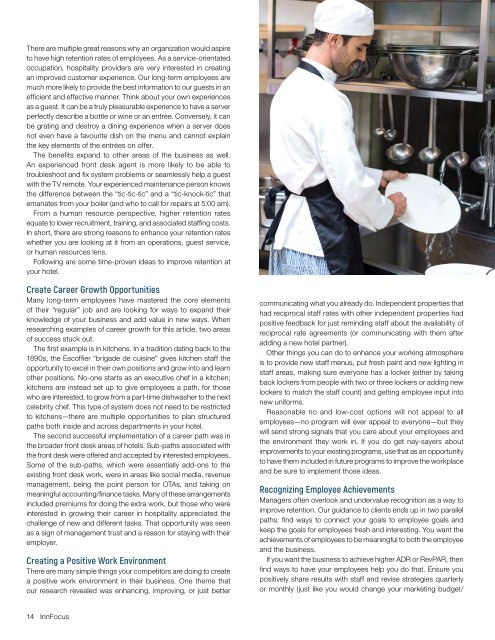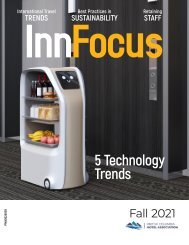InnFocus Winter 2023
InnFocus magazine for hoteliers in British Columbia
InnFocus magazine for hoteliers in British Columbia
You also want an ePaper? Increase the reach of your titles
YUMPU automatically turns print PDFs into web optimized ePapers that Google loves.
There are multiple great reasons why an organization would aspire<br />
to have high retention rates of employees. As a service-orientated<br />
occupation, hospitality providers are very interested in creating<br />
an improved customer experience. Our long-term employees are<br />
much more likely to provide the best information to our guests in an<br />
efficient and effective manner. Think about your own experiences<br />
as a guest. It can be a truly pleasurable experience to have a server<br />
perfectly describe a bottle or wine or an entrée. Conversely, it can<br />
be grating and destroy a dining experience when a server does<br />
not even have a favourite dish on the menu and cannot explain<br />
the key elements of the entrées on offer.<br />
The benefits expand to other areas of the business as well.<br />
An experienced front desk agent is more likely to be able to<br />
troubleshoot and fix system problems or seamlessly help a guest<br />
with the TV remote. Your experienced maintenance person knows<br />
the difference between the “tic-tic-tic” and a “tic-knock-tic” that<br />
emanates from your boiler (and who to call for repairs at 5:00 am).<br />
From a human resource perspective, higher retention rates<br />
equate to lower recruitment, training, and associated staffing costs.<br />
In short, there are strong reasons to enhance your retention rates<br />
whether you are looking at it from an operations, guest service,<br />
or human resources lens.<br />
Following are some time-proven ideas to improve retention at<br />
your hotel.<br />
Create Career Growth Opportunities<br />
Many long-term employees have mastered the core elements<br />
of their “regular” job and are looking for ways to expand their<br />
knowledge of your business and add value in new ways. When<br />
researching examples of career growth for this article, two areas<br />
of success stuck out.<br />
The first example is in kitchens. In a tradition dating back to the<br />
1890s, the Escoffier “brigade de cuisine” gives kitchen staff the<br />
opportunity to excel in their own positions and grow into and learn<br />
other positions. No-one starts as an executive chef in a kitchen;<br />
kitchens are instead set up to give employees a path, for those<br />
who are interested, to grow from a part-time dishwasher to the next<br />
celebrity chef. This type of system does not need to be restricted<br />
to kitchens—there are multiple opportunities to plan structured<br />
paths both inside and across departments in your hotel.<br />
The second successful implementation of a career path was in<br />
the broader front desk areas of hotels. Sub-paths associated with<br />
the front desk were offered and accepted by interested employees.<br />
Some of the sub-paths, which were essentially add-ons to the<br />
existing front desk work, were in areas like social media, revenue<br />
management, being the point person for OTAs, and taking on<br />
meaningful accounting/finance tasks. Many of these arrangements<br />
included premiums for doing the extra work, but those who were<br />
interested in growing their career in hospitality appreciated the<br />
challenge of new and different tasks. That opportunity was seen<br />
as a sign of management trust and a reason for staying with their<br />
employer.<br />
Creating a Positive Work Environment<br />
There are many simple things your competitors are doing to create<br />
a positive work environment in their business. One theme that<br />
our research revealed was enhancing, improving, or just better<br />
communicating what you already do. Independent properties that<br />
had reciprocal staff rates with other independent properties had<br />
positive feedback for just reminding staff about the availability of<br />
reciprocal rate agreements (or communicating with them after<br />
adding a new hotel partner).<br />
Other things you can do to enhance your working atmosphere<br />
is to provide new staff menus, put fresh paint and new lighting in<br />
staff areas, making sure everyone has a locker (either by taking<br />
back lockers from people with two or three lockers or adding new<br />
lockers to match the staff count) and getting employee input into<br />
new uniforms.<br />
Reasonable no and low-cost options will not appeal to all<br />
employees—no program will ever appeal to everyone—but they<br />
will send strong signals that you care about your employees and<br />
the environment they work in. If you do get nay-sayers about<br />
improvements to your existing programs, use that as an opportunity<br />
to have them included in future programs to improve the workplace<br />
and be sure to implement those ideas.<br />
Recognizing Employee Achievements<br />
Managers often overlook and undervalue recognition as a way to<br />
improve retention. Our guidance to clients ends up in two parallel<br />
paths: find ways to connect your goals to employee goals and<br />
keep the goals for employees fresh and interesting. You want the<br />
achievements of employees to be meaningful to both the employee<br />
and the business.<br />
If you want the business to achieve higher ADR or RevPAR, then<br />
find ways to have your employees help you do that. Ensure you<br />
positively share results with staff and revise strategies quarterly<br />
or monthly (just like you would change your marketing budget/<br />
14 <strong>InnFocus</strong>
















